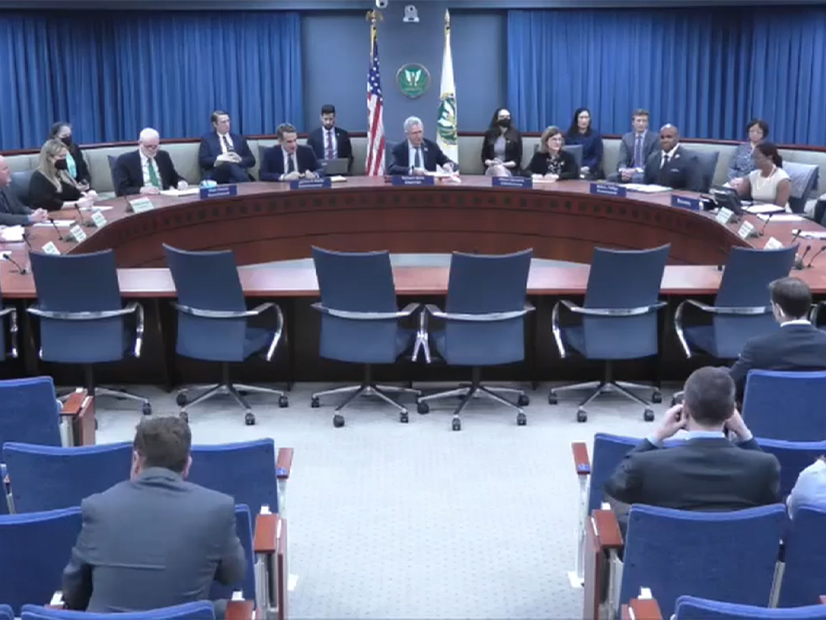FERC on Thursday proposed changing transmission planning and cost allocation processes in the first in what may be a series of initiatives to help build out the grid in response to electrification and the shift to renewable generation (RM21-17).
 FERC met in person for its monthly open meeting for the first time in more than two years, though the meeting was not open to the press or public, only commissioners and staff. | FERC
FERC met in person for its monthly open meeting for the first time in more than two years, though the meeting was not open to the press or public, only commissioners and staff. | FERCMeeting in person for the first time after more than two years of telework during the COVID-19 pandemic, the commission voted 4-1 to issue the Notice of Proposed Rulemaking, which would direct transmission providers to revise their planning processes to, among many other things, identify infrastructure needs on a long-term, forward-looking basis and propose a list of benefits on which they would base their selections of proposed projects to meet those needs.
The majority of the commission said the proposal would help planning entities, including RTOs and ISOs, prepare for the growth of renewables, new sources of demand such as electric vehicles and extreme weather events, expected to increase as climate change worsens. In a separate order Thursday, the commission ordered the five jurisdictional RTOs and ISOs to report on how those forces were changing their system needs and what new market rules were required to satisfy them. (See related story, FERC Asks RTOs for Plans on Changing Market Needs.)
“If today’s proposed rule is finalized, it will facilitate much needed transmission investment, improving the resilience of the grid, enhancing reliability and reducing power costs,” Chair Richard Glick said. “It’s also going to address our nation’s changing resource mix and the changing role of electricity in our society.”
The NOPR follows an Advance Notice of Proposed Rulemaking issued in July 2021, which covered a wider range of topics. The results of the ANOPR, which drew hundreds of stakeholder comments, has been highly anticipated by not just transmission developers, but the renewable energy industries as well. (See FERC Tx Inquiry: Consensus on Need for Change, Discord over Solutions.)
The NOPR would not change planning and cost allocation rules for reliability or market efficiency projects, Commissioner Mark Christie noted. “We don’t want to mess with them, and we’re not,” he said. But it would require planners become more proactive in planning for what Order 1000 called “public policy” projects.
The proposed rule would:
- require transmission providers to conduct regional transmission planning on a long-term, forward-looking basis to meet transmission needs driven by changes in the resource mix and demand;
- require transmission providers to identify transmission needs through multiple scenarios that incorporate factors such as federal, state and local laws and regulations that affect the future resource mix and demand; trends in technology and fuel costs; resource retirements; generator interconnection requests and withdrawals; and extreme weather events;
- broaden the benefits that could be considered for project selection and cost allocation;
- require transmission providers to seek the agreement of relevant state entities regarding cost allocation; and
- require an ex-ante cost allocation method or a state agreement process in which states can voluntarily agree to fund a project, or a combination of the two.
“The clean energy industry is developing thousands of megawatts of clean energy resources — but many projects are stymied by a lack of transmission capacity,” the American Clean Power Association said in a statement. “FERC’s proposed rule has the potential to accelerate backbone transmission development planning, ensure fair and consistent cost allocation, and provide a substantial role for states in planning transmission for the future.”
Many other stakeholder groups issued statements applauding the proposal, though some were more lukewarm. Many called it a “first step,” while Sarah Ladin, senior attorney at the Institute for Policy Integrity, said the proposal was “a modest but important step toward more efficient planning that can facilitate decarbonization.”
Glick assured stakeholders during the meeting that the commission had not forgotten about the ANOPR’s other issues, such as the backlogged generation interconnection queues, interregional transmission planning and incentives. Speaking to reporters after the meeting, Glick advised against taking “the fact that we did a NOPR today on transmission planning and cost allocation to suggest that there wasn’t enough support for any of those other issues. Just the contrary. …
“After all the comments came in on the ANOPR, we realized that there’s a lot here; there’s a lot of meat on the bone, so to speak. And we thought if we tried to handle to every single issue … in one big rulemaking, it would take forever. So, we thought we would streamline it into several different rulemakings. …
“My great hope is that in the very near future, we’ll able to issue a NOPR on interconnection reform, which is very important. … [But] we didn’t think it was wise to do it all in one big rulemaking.”
While perhaps not a complete overhaul, the proposal would result in significant changes to transmission planning. RTOs, for example, would be required to create scenarios, with a minimum time horizon of 20 years, that forecast changes in resource mixes and the probability of extreme weather events. Planners would then evaluate project proposals based on FERC-approved criteria that recognize the benefits over the time period for the purposes of cost allocation
Right of First Refusal
Among the most significant changes would be an exception to Order 1000’s elimination of the federal right of first refusal (ROFR).
FERC said regional transmission facilities subject to competitive procurements represent only a small portion of transmission investment in recent years and that Order 1000’s removal of the federal ROFR may be “inadvertently discouraging investment” in regional transmission.
Incumbent transmission providers “may be presented with perverse investment incentives” to instead engineer local transmission projects for which they retain development control, the commission said.
It proposed allowing an incumbent to exercise a federal ROFR for a regional project on the condition that it partner with an unaffiliated company with a “meaningful level of participation and investment” in the project.
While that change would be a win for incumbent transmission owners, the commission also proposed new procedures to ensure they don’t replace aging transmission infrastructure without evaluating whether they could be “right sized” to provide more cost-effective solutions to regional transmission needs.
Construction Work in Progress
Developers would also not be permitted to take advantage of the commission’s construction-work-in-progress (CWIP) incentive for their selected projects. Planners would also be required to seek state approval of their proposed cost allocation methods.
Those requirements were key to Christie’s support for the proposal. He said that CWIP puts consumers at risk by allowing developers to be paid “before a single ounce of steel is put into the ground, much less the project is in service.” Instead, pre-construction costs would be “booked” as allowance for funds used during construction (AFUDC).
“With AFUDC, the developer gets to book the costs but cannot collect from the consumers until the project is in service,” he said.
The former Virginia State Corporation Commission chairman was also exuberant about the provisions to include state input and approval. In this he disagreed with Commissioner James Danly, who dissented because, he said, “I don’t like the purpose of this NOPR.
“It is designed to encourage buildout of transmission specifically for the purpose of encouraging the development of certain types of resources. That is something that I think is not appropriately a concern of the commission. And it does so by socializing costs through putting public policy choices — that is, state and, if you can believe it, even local public policy choices — front and center in the transmission planning process.”
Commissioner Allison Clements rejected Danly’s criticism.
“It is also not a policy action to advance renewable energy interests. To so frame the proposed long-term transmission planning reforms, or to portray transmission planning as a zero-sum game, misses the point,” she said. “Rather, the proposal contains a sensible suite of reforms to shore up cost protections and reliability of the U.S. electricity system based on clear market signals about generation development and demand, the risks of extreme weather and the increasing threat of cyber and physical attack.”
Christie said the addition of a state role in cost allocation was “probably the single biggest reason” he voted for the proposal.
“For the first time, it puts states formally at the heart of the planning for these types of projects,” he said. “States are going to be at the heart of the planning. States are going to get the opportunity to agree to the criteria, and they’re going to get the opportunity to agree to the cost allocation. This has never been a formal requirement in FERC’s transmission regulation.”
Comments on the NOPR will be due in 75 days from publication in the Federal Register.




